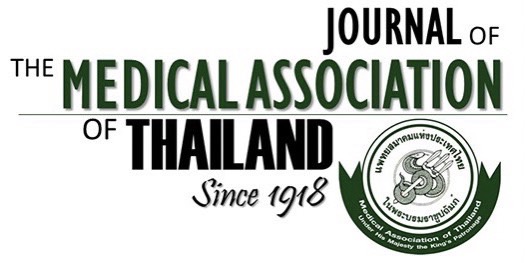The Thai Anesthesia Incidents Study (THAI Study) of Morbidity after Spinal Anesthesia: A Multi-centered Registry of 40,271 Anesthetics
Somrat Charuluxananan MD*, Somboon Thienthong MD**, Mali Rungreungvanich MD***, Thavat Chanchayanon MD****, Thitima Chinachoti MD*****, Oranuch Kyokong MD*, Yodying Punjasawadwong MD*****
Affiliation : * Department of Anesthesiology, Chulalongkorn University, Bangkok ** Department of Anesthesiology, Khon Kaen University, Khon Kaen *** Department of Anesthesiology, Ramathibodi Hospital, Mahidol University, Bangkok **** Department of Anesthesiology, Prince of Songkla University, Songkhla ***** Department of Anesthesiology, Siriraj Hospital, Mahidol University, Bangkok ****** Department of Anesthesiology, Chiang Mai University, Chiang Mai
Background : The present study was part of the Thai Anesthesia Incidents Study (THAI Study) of anesthetic
adverse outcomes.
Objective : Study complications after spinal anesthesia.
Materials and Methods : During the 12 month period (March 1, 2003 – February 28, 2004), a prospective multi-
centered descriptive study was conducted in 20 hospitals comprised of seven university, five tertiary, four
general and four district hospitals across Thailand. Anesthesia personnel filled up patient-related, surgical-
related, and anesthesia-related variables and adverse outcomes of all consecutive patients receiving anesthe-
sia on a structured data entry form. The data were collected during pre-anesthetic, intra-operative, and 24 hr
post operative period. Adverse event specific forms were used to record when these incidents occurred. Data
were reviewed by three independent reviewers and analyzed to identify contributing factors by consensus.
Results : This was registry of 40,271 spinal anesthetics from 172,697 anesthetics. The incidence of total spinal
anesthesia, neurological complications, suspected myocardial ischemia, or infarction and oxygen desaturation
per 10000 spinal anesthetics were 3.48 (95% CI 1.66-5.30), 1.49 (95% CI 0.30-2.68), 2.73 (95% CI 1.12-
4.35), 0.99 (95% CI 0.39-2.56), and 6.46 (95% CI 3.98-8.94) respectively. This was not different to the
incidence in other countries. Risk factors of oxygen desaturation were shorter in height [OR 0.95 (95% CI
0.92-0.97); p < 0.001], higher ASA physical status [OR 3.37 (95% CI 1.98-5.72); p < 0.001], and use of
propofol [OR 5.22 (95% CI 1.78-15.35); p = 0.003]. Other complications such as seizure, anaphylactic or
anaphylactoid reaction, drug error, and pulmonary aspiration were scarce. There was no case of mismatched
blood transfusion in the present study.
Conclusion : Incidence of total spinal block, neurological complication, and suspected myocardial ischemia
or infarction was uncommon. Risk factors of oxygen destruction were shorter in height, higher ASA physical
status, and use of propofol. Some events were considered avoidable and preventable.
Keywords : Spinal anesthesia, Complication, Total spinal block, Nerve injury, Desaturation



